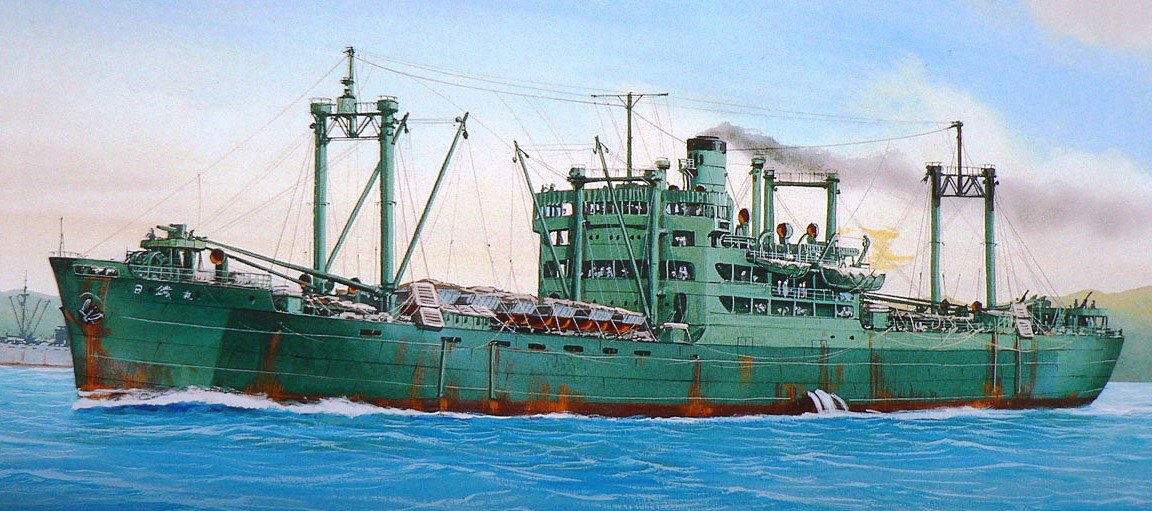KOSEKI UMPANSEN
 (Wartime ore carrier by Ueda Kihachiro)
(Wartime ore carrier by Ueda Kihachiro)
GYOKUREI MARU:
Tabular Record of Movement
© 2011 Bob Hackett
E 1942:
Kobe. Laid down at Mitsubishi Jukogyo K. K. as a 5,588-ton ore carrier for Toa Kaiun K. K., Tokyo.
1943:
Launched and named GYOKUREI MARU.
May 1943:
Completed.
18 June 1943:
At 0500, GYOKUREI MARU departs Imari Bay for Shanghai,
China in a convoy consisting of WAKAMATSU, UGA, MIIKESAN, KOSHIN, WAZAN, TOKIWA
and NICHINAN MARUs and an unidentified escort. [1]
E China Sea. At 1830, LtCdr (later Admiral/CINCPAC) John S. McCain, Jr’s
(USNA '10) USS GUNNEL (SS-253) sights the convoy approaching, smoking heavily and making
maximum speed. About every ten minutes, the convoy changes course through forty
to sixty degree zigzags. GUNNEL's XO/navigator plots the convoy's base course as
260°(T) towards Shanghai.
19 June 1943:
E China Sea. At 0825, after making an "end-around",
McCain torpedoes and sinks TOKIWA MARU at 32-31N, 126-17E. One crewman is KIA.
The remainder of the convoy escapes. At 1410, they anchor off Saishu To (former
Quelpart Island, now Cheju-do, Korea).
7 July 1943:
At 1400, GYOKUREI MARU departs Moji in convoy No. 173
also consisting of ASAKA, HIROTA, MURORAN, RYUKO, TAIYU, KYOKKO and NACHISAN
MARUs and tankers ZUIYO and KOSHIN MARUs and KYOEI MARU No. 2 escorted by
torpedo boat HAYABUSA and patrol PB-36.
13 July 1943:
At 0950, arrives at Takao. 3 September 1943:
At 0840,
GYOKUREI MARU departs Mako, Pescadores for Sasebo in convoy No. 299 also
consisting of HONAN, COLUMBIA, REIYO, NAPLES, ASO and HASSHU (YASHIMA) MARUs
escorted by patrol boat PB-36.
14 September 1943:
SUGIYAMA and MATSUURA MARUs join the convoy at sea.
17 September 1943:
HASSHU (YASHIMA) MARU is detached for Pusan.
18 September 1943:
At 1230, arrives at Sasebo. 10 October
1943:
At 1505, GYOKUREI departs Moji in convoy No. 105 also consisting of TEIKAI MARU (ex-German FULDA), CHICAGO, AMERICA, , MIKASA, HEIAN, NICHIEI and GYOTEN MARUs and tankers SAN RAMON and MITSU MARUs escorted by destroyer
SHIOKAZE.
15 October 1943:
At 0110, LtCdr (later KIA) Charles F. Brindupke's (USNA '32) USS TULLIBEE (SS-284) torpedoes and sinks CHICAGO MARU at 24-30N, 120-26E. 43 troops and eight crewmen are KIA. Over the next five hours, GYOKUREI, SAN RAMON and NICHIEI MARUs rescue survivors. Later that day arrives at Takao.
19 November 1943:
GYOKUREI MARU departs Moji in convoy No. 115 also consisting of transport NIPPONKAI MARU and cargo LONDON MARU, tankers OGURA MARU
No. 1 and KOTO MARU No. 2 GO and three unidentified merchant ships escorted by auxiliary gunboat CHOHAKUSAN MARU. Several of these vessels departed from Sasebo and joined convoy. Soon after departure, CHOHAKUSAN MARU's engine breaks down
and she returns to port.
24 November 1943:
At 0400, GYOKUREI MARU is detached for Keelung at
26-0N,120-10E and KOTO MARU No. 2 GO is detached for Hong Kong.
15 December 1943:
At 1500, GYOKUREI MARU departs Takao for Moji in
convoy No. 227 also consisting of SEATTLE, HORAIZAN, NIGITSU, KENREI, NIKKO and
HOREI MARUs and KOTO MARU No. 2 escorted by destroyer NUMAKAZE. GYOKUREI MARU is
carrying 8,000-tons of iron ore that she loaded at Hainan, China.
16 December 1943:
ORYOKU and TEIYO MARUs join the convoy at Keelung.
At 0905 (K) lookouts aboard LtCdr (later KIA) John A. Moore’s (USNA '32) USS
GRAYBACK (SS-208) spot smoke on the horizon at about 14 miles distant. At 1021,
GRAYBACK submerges to make an approach on a seven-ship convoy. At 1150,
GRAYBACK’s crew spots an aircraft over the convoy. At 1535, GRAYBACK spots
another aircraft over the convoy and submerges. At 1917, GRAYBACK’s SJ radar
picks up the convoy at 23,000 yards arrayed in two columns covered by three
escorts (one large warship and two smaller subchasers).
At 2219 (K), Moore fires a spread of four torpedoes from the surface at
the second and third ships in column. The escorts open fire and shells pass over
the submarine. GRAYBACK crash-dives. At 2120, GYOKUREI MARU is hit under the
bridge in the engine room. A huge column of flame erupts and she takes on a
sharp list then sinks at 26-30N, 128-15E. 62 crewmen are KIA.
19 December 1943:
50 miles ENE of Naha, Okinawa. At 0107 (K), GRAYBACK
surfaces to continue her attack on the convoy, but at 0205 her SJ radar picks up
a contact closing rapidly down the submarine’s wake. Moore crash-dives and comes
hard right. At 0231, GRAYBACK fires her four stern torpedoes at an escort making
17 knots. At least three torpedoes hit destroyer NUMAKAZE and detonate five or
six of her DCs. She disintegrates and sinks with all hands at 26-29N, 128-26E.
At 1800, USN codebreakers intercept and decrypt a signal from the CO of
DesDiv 11 that reads: "The entire bow of NUMAKAZE has broken off from three
meters above vicinity -----. There is a hole above and below the waterline on
both sides of the ship forward of #1 main bulkhead. Another hole along the #7
beam starboard side above waterline 1 meter and about 30 centimeters. Have
completed one patch and able to do eighteen knots.”
At 2130, USN codebreakers intercept and decrypt another signal that
reads: “NUMAKAZE under tactical command commander DesDiv 1 left Takao escorting
convoy No. 227. Route Moji. On 18 December at 2130 in position 26-30N, 128-13E
reported sighting enemy submarine and depth charging same. Since then, nothing
has been heard from said vessel. ----. A large quantity of material washed
ashore at Betozaki in Okinawa.”
Authors' Notes:
[1] Some sources do not list HONG KONG MARU as a member of
the convoy or TSUBAME as an escort; however, Alden shows TOKIWA and HONG KONG
MARUs as both sunk in the same place on the same day. According to COMSUBPAC's
SORG, GUNNEL was the only submarine in the area at the time.
Author's Note:
Thanks go to John Whitman for info on USN decrypts.
- Bob Hackett
Back to the Ore
Carriers Page





